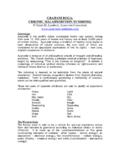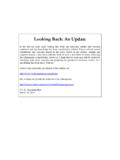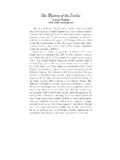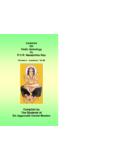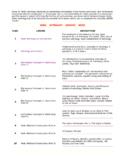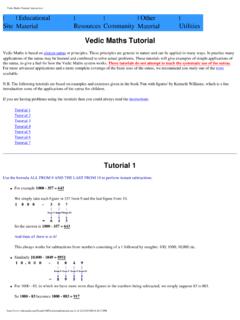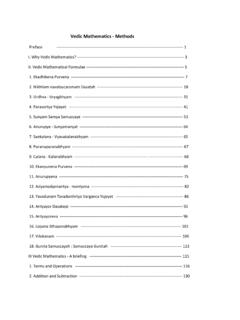Transcription of An Ayurvedic approach to Obesity - Ayurveda …
1 An Ayurvedic approach to Obesity by Jeyashanthy Murugakumar An Ayurvedic approach to Obesity Obesity is a condition in which an individual is significantly overweight, and an excessive amount of body fat has accumulated under the chin and on the beasts, belly, buttocks, and/or thighs. Though it is not a serious case in itself, it may shorten the span of life, as well as create diminished efficiency and happiness. Obesity has become an epidemic in North America. Recent figures show that in the past two decades the number of overweight children and adolescents has doubled. Diabetes, heart disease, stroke, hypertension, high cholesterol, some types of cancers are major health risks due to Obesity . Causes of Obesity include overeating, excessive intake of heavy or cold food and drinks, oversleeping, lack of exercise, frequent snacking, eating processed food and leftovers, eating while multi-tasking and eating food that is not suitable to one's body type.
2 Ayurveda and its approach : Ayurveda is 5000 year old and has a holistic approach to life. In Ayurveda , Obesity is regarded as medoroga, a disorder of meda dhatu, which includes fat tissue and fat metabolism. According to Ayurveda Obesity begins with imbalance of doshas (Vata, Pita, and Kapha), an imbalance of agni (digestive fire), an imbalance of the malas (waste products) or an imbalance of shrotas (microcirculatory channels). This collection of imbalances then interferes with the formation of tissues or dhatus and leads to a tissue imbalance that we experience as excess weight. From the Ayurvedic perspective, the key cause is found in lifestyle and diet choices that disrupt balance. Ayurveda views weight imbalance and Obesity as something that should be corrected before it can contribute to other health problem.
3 JM Page 2. An Ayurvedic approach to Obesity Ayurvedic word for digestion and metabolism is agni. Agni, when loosely translated, means fire. It actually signifies something much more than just fire and includes the idea of a precise and powerful functioning intelligence. Agni has remarkable transformative qualities. All the food we take in must be transformed into that which can be made useful by the body (nutrients) and that which is not needed (waste). The nutrients, or most refined products of our agni, are used to create the body's tissues ( dhatus). The Vicious Cycle There are seven dhatus, and they are created sequentially. The creation of dhatus is an ongoing complex process. The key word is sequential. If at any stage there is an imbalance, this disrupts the whole sequence of tissue formation.
4 The shrotas or channels play a big role, because they carry the information required to properly form the tissues step by step. If blockages occur in the shrotas due to toxins (ama), an imbalance starts. According to Ayurveda to maintain balance and health strong agni and clear shrotas are essential. From Ayurvedic perspective the cause of weight gains is cyclical. It begins with balance reducing choices in diet and lifestyle that weaken the digestive fire, which in turns increases toxins, clogging the communication channels shrotas and thereby disrupting the formation of tissues. The poorly formed tissue layers increases meda dhatu and an imbalance in Kapha Dosha. This in turn increases accumulation of toxins (ama), which leads to imbalance in meda dhatu. JM Page 3. An Ayurvedic approach to Obesity Accumulation of ama in shrotas causes an imbalance in naturally-flowing Vata energy.
5 Restricted or imbalanced Vata energy ends up increasing agni the digestive fire leading to an increase in appetite and thirst. This leads in turn to an increase in Kapha Dosha and meda dhatu and the whole cycle starts again. To break the cycle, the Ayurvedic expert (vaidya) determines the unique nature of the individual (Prakriti) and the nature of imbalance (Vikriti). The essence of recommendation is generally comes down to addressing a few core issues: strengthening digestion (balance agni), removing ama, improving dietary habits and adjusting inappropriate daily routines and lowering stress. Vata: A balanced vata is creative, artistic, sensitive, spiritual and funny. When not in balance vata is nervous, anxious and restless. Stressful job or rocky relationship could lead to lack of sleep or worry, anxiety, fatigue and depression.
6 Vata is associated with air and ether elements, which causes unstable mood and mind and as a result irregular appetite. Vatas becomes ultimate grazers, mostly because lack of routine and order to plan a meal. Eating lots of sugar calms the nerves as well as eating lots give vata a sense of security. Pitta: Pitta is driven, competitive, ambitious and constantly chasing the next goal. Pita is intelligent and razor-sharp focus. Hunger is very intense in Pita. But pitas frequently forget to eat and can't stop what they are doing to eat something healthy. They become absorbed in their task whatever they are doing. When it is time to eat pita overeats, and full of cravings, because craving is JM Page 4. An Ayurvedic approach to Obesity instantly gratified with ample of sugar, coffee and red meat. They become addicted to such food.
7 Weight develops muscle and flabbiness. Kapha: Kapha moves through life at a slow, methodical space. They are calm, easy going, affectionate and content. Kapha is associated with earth and water elements. When not in balance this is the most common Dosha that develops Obesity , slow metabolism, easy weight gain, continuous appetite (addiction to eat), hypothyroid or other hormonal conditions that cause retention of weight, mainly water and fat, weak pancreas and kidneys, low pulse and energy, excess phlegm, fat deposits and benign tumors may develop. Guidelines: Hydrate with warm water: 75% of Americans are chronically dehydrated. According to Ayurveda , warm water is a natural detoxifier. Warm water mops up impurities as it travels through over-taxed digestive system, sweeping away molecules left behind from partially digested food that could be slowing down what nature intended to be an enviably swift metabolic rate.
8 Replacing sugary beverages like soda and fruit juices with clear warm water automatically reduces number of calories per day. Cold drinks cause the muscles and blood vessels in gastrointestinal tract to freeze and in turn vitiate digestive fire, which leads sluggish digestion. Warm water, on the other hand, relaxes the JM Page 5. An Ayurvedic approach to Obesity muscles and dilates the blood vessels. Dilation of blood vessels allows the assimilation and absorption of the contents of the meal to occur more efficiently. Sipping water during meal is ideal. It helps digestion, absorption and dhatu building. The rule of thumb is drink of capacity of the stomach while eating. Drinking water before meal will dilute agni, which will hinder digestion and lead to weakness. Drinking water right after meal will increase Kapha, causing weight gain.
9 Ideal time to drink water is right after waking up in the morning and one hour before and one hour after each meal. The quantity of water consumption varies with body type; Vata needs more water than Kapha type. Drink a cup of hot water with a teaspoon honey and 10 drops of lime juice added whenever feel hungry will be a good substitute for eating and will help to melt the fat. (The complete book of Ayurvedic Home Remedies by Dr. Vasant Lad). Mindful eating: A study in the British Medical Journal has discovered that people who eat quickly are three times more likely to be overweight than those who take their time. While eating zoning out, watching TV, talking, driving, and multi-tasking undermine the digestive process and counteract the effort to lose weight. Mindful eating means it is about being conscious and present while eating.
10 When food is eaten mindfully, the brain sees, tastes, smell and feels and sends signals to the stomach to release enzymes and juices to digest the food. According to Ayurveda , you are not what you eat but what you digest. The first stage of digestion starts in the mouth with Bodhaka Kapha. The moment that any kind of food or substance comes in contact with saliva JM Page 6. An Ayurvedic approach to Obesity (Bodhaka Kapha), the first experience is taste. Ayurveda says that taste has direct actions on doshas, so the moment you start eating food the process of digestion begins. The digestive process is governed by agni and certain subtypes of each three doshas. Usually six or more hours are required for the digestion of a meal. In order to lose weight and reach optimal level of agni it is important to avoid the following: Avoid overeating and/or eating heavy foods in large quantities Avoid tamasic foods: Leftovers, processed, canned foods, fast food or food with additives and colorings Avoid ice cold water and drinks and cold foods Quit drinking alcohol and smoking Avoid cruciferous vegetables, fried foods and heavy foods Do not talk or laugh while eating.
